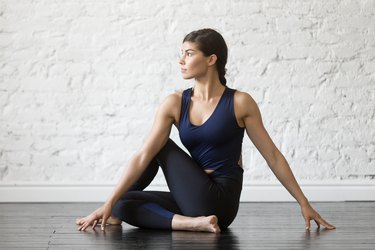
Core strength and balance exercises should be part of everyone's workout routine, advises the Mayo Clinic. A waist-twisting disc exercise may help you address both in one fell swoop. You can do a variety of exercises on the board that can tone other muscle groups too.
Waist-Twisting Discs Explained
Video of the Day
A waist-twisting disc is a novel piece of home exercise equipment with a rotating platform. The bottom disc is static, and the top disc rotates on top of the bottom disc. To operate it, you stand or sit on it and rotate your torso so that your shoulders and chest go in one direction and your hips and knees go in the opposite direction.
Video of the Day
This type of motion activates all the core muscles, which include muscles in your abdomen, your oblique muscles along the sides of your torso and muscles in your lower and midback, according to the American Council on Exercise. With correct form, you should feel these muscles working and begin to fatigue.
Waist-twisting discs may also come with resistance bands attached. You can use these to perform a host of other exercises for the whole body. Doing this on an unstable surface increases the challenge and improves balance.
As for its effectiveness, no scientific research has been conducted to evaluate waist-twisting disc results, so there is no guarantee that it actually works. Try it and see if it works for you. If not, there are many other ways to strengthen your core and the rest of your body that are proven to work.
Waist-Twisting Disc Exercises
The twisting wait-disc exercise equipment is versatile, allowing for many different exercise variations for everyone from beginners to advanced exercisers. Here are a few to get you started:
Move 1: The Basic Twist
- Stand on the disc with your feet slightly narrower than hip-distance apart. If there are markings for your feet, align your stance with them.
- Keep your torso erect and your core contracted.
- Initiate the move by turning your torso in one direction and your hips and knees in the other direction. Keep the movement small to begin with.
- Rotate back through the center; then turn your torso and hips in the other direction.
- Continue to do this, making your transitions as fluid as possible. If you feel stable, you can try twisting a little further in each direction and increasing the speed of your twist.
Tip
Increase the challenge of the basic twist by bending your knees either a little or a lot. This will make it more difficult to balance and will increase the work your legs have to do. You can also bend your arms at your elbows and swing them back and forth — as if you were speed walking — to increase the cardiovascular challenge.
Move 2: Squat Twist
- Stand on the disc as you did in the basic twist.
- Bend your knees to a 45-degree angle.
- Rotate your knees in the opposite direction as your chest.
- Come back through center and turn to the other side.
- Keep the bend in your knees throughout the exercise.
Move 3: Seated Twist
- Position the waist-twisting disc on the floor and sit down on it.
- Place your hands lightly on the floor behind you for support. Keep your knees bent and your toes on the floor for support to start.
- Rotate your hips in one direction and your shoulders in the other.
Tip
Increase the challenge of this exercise by lifting your hands, feet or both off the floor. Make it even harder by leaning your torso back at a greater angle and extending your legs.
There are many more exercises you can do with the resistance bands attached to the waist-twisting disc, if yours comes equipped with bands. Do biceps curls or shoulder raises as you twist or squat. You can also use two waist-twisting discs at one time, placing one foot on each disc. Many manufacturers of waist-twisting discs will include a guide with different exercises or a link to an online video that shows you some of the other exercises you can do.
Read more: 5 Benefits of Abdominal Strength & Endurance
Warning
According to the American Council on Exercise, twisting movements are contraindicated for people with low back pain. If you have back pain, speak with your doctor before performing waist-twisting disc exercises. The American Pregnancy Association also warns pregnant women to avoid twisting exercises while standing during pregnancy.